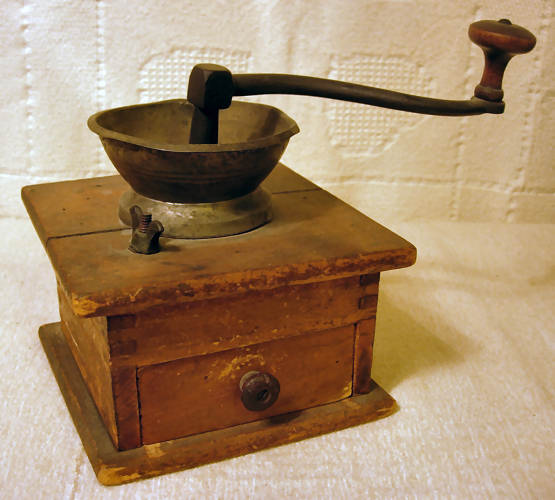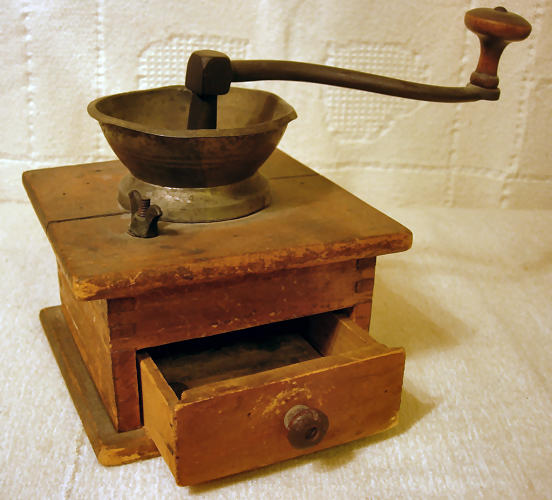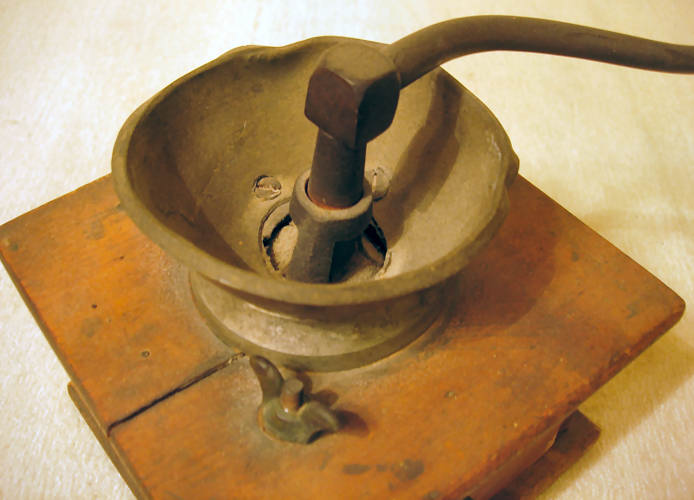

![]() Although it may sound too fantastical to be true, there was a time when Starbucks didn't exist. This post has to do with an object that was used by almost every family even long before coffee was carried by Juan Valdez on the back of his mule, Conchita.
Although it may sound too fantastical to be true, there was a time when Starbucks didn't exist. This post has to do with an object that was used by almost every family even long before coffee was carried by Juan Valdez on the back of his mule, Conchita.

![]() The coffee grinder was a personal means of grinding coffee beans, and just about every family owned at least one. The antique coffee grinder shown here was what was called a burr-grinding coffee mill. It employed two wheels or grinding elements between which the coffee beans passed. The grinding elements crushed the beans between them, tearing them open to release the essential oil that makes coffee taste the way it does. The coffee grinder has two thumbscrews that altered the distance between the grinding elements, therefore allowing the homeowner to change the size of the crushed pieces ~ therefore changing the amount of essential oil being released.
The coffee grinder was a personal means of grinding coffee beans, and just about every family owned at least one. The antique coffee grinder shown here was what was called a burr-grinding coffee mill. It employed two wheels or grinding elements between which the coffee beans passed. The grinding elements crushed the beans between them, tearing them open to release the essential oil that makes coffee taste the way it does. The coffee grinder has two thumbscrews that altered the distance between the grinding elements, therefore allowing the homeowner to change the size of the crushed pieces ~ therefore changing the amount of essential oil being released.

![]() The homeowner would pour coffee beans into the bowl shaped receptacle at the top of the grinder. Then, with one hand holding the grinder firmly on some work surface, the handle would be turned, with the other hand, in a clockwise direction until all the beans would be moved through the bottom of the bowl. The result of this action would be that the beans would be crushed into pieces and deposited into the drawer in the grinder's body. The process would be repeated until the desired quantity would be obtained.
The homeowner would pour coffee beans into the bowl shaped receptacle at the top of the grinder. Then, with one hand holding the grinder firmly on some work surface, the handle would be turned, with the other hand, in a clockwise direction until all the beans would be moved through the bottom of the bowl. The result of this action would be that the beans would be crushed into pieces and deposited into the drawer in the grinder's body. The process would be repeated until the desired quantity would be obtained.
![]() The coffee grinder shown here was constructed of wood, with its sides dovetailed together and the top and bottom pieces nailed on with small headed brads. The bowl and grinding mechanism is made of metal ~ the bowl being a soft metal such as a tin alloy. The great thing about this antique is that it retains a slight aroma alluding to its purpose.
The coffee grinder shown here was constructed of wood, with its sides dovetailed together and the top and bottom pieces nailed on with small headed brads. The bowl and grinding mechanism is made of metal ~ the bowl being a soft metal such as a tin alloy. The great thing about this antique is that it retains a slight aroma alluding to its purpose.

![]() Although some coffee connoisseurs would claim that coffee has to be either percolated or steeped to be potable (i.e. drinkable), in the early days, the crushed coffee bean pieces would then be dumped into a coffee pot, water would be added, and the pot would be placed either on a ledge in the fireplace or on a stove burner to heat. The heated liquid would be poured through a strainer and into a cup, the strainer catching any floating pieces of the coffee beans.
Although some coffee connoisseurs would claim that coffee has to be either percolated or steeped to be potable (i.e. drinkable), in the early days, the crushed coffee bean pieces would then be dumped into a coffee pot, water would be added, and the pot would be placed either on a ledge in the fireplace or on a stove burner to heat. The heated liquid would be poured through a strainer and into a cup, the strainer catching any floating pieces of the coffee beans.
![]() The work required to obtain a cup of coffee by grinding the beans in one of these mills probably made the end result taste delicious.
The work required to obtain a cup of coffee by grinding the beans in one of these mills probably made the end result taste delicious.
